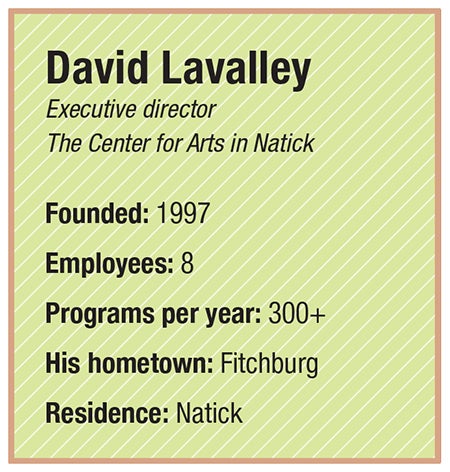Lavalley, the executive director, is in his 19th year in charge and trying to keep the nonprofit’s legacy alive while it continues to transform to something new in its post-COVID existence.
Get Instant Access to This Article
Subscribe to Worcester Business Journal and get immediate access to all of our subscriber-only content and much more.
- Critical Central Massachusetts business news updated daily.
- Immediate access to all subscriber-only content on our website.
- Bi-weekly print or digital editions of our award-winning publication.
- Special bonus issues like the WBJ Book of Lists.
- Exclusive ticket prize draws for our in-person events.
Click here to purchase a paywall bypass link for this article.
Michael Moran founded The Center for Arts in Natick as a place for people to meet, experience, and create art. The vision was initially for a coffeehouse in Natick Center serving as an informal club for artists and members. The nonprofit leased a storefront on Main Street in the center of town and started hosting open mics for local songwriters, community theater productions, art exhibitions, and weekly jazz sessions. As it grew, it began to add more programs and live music series.

In 1998, it outgrew the space and purchased the historic Central Fire Station from the Town of Natick in October 1998. After years of renovations, the new space opened in 2003.
David Lavalley started working for TCAN in 2004, the same year Moran was dismissed by the nonprofit’s board. Today, the nonprofit hosts more than 300 events – between live shows, educational programming, movies, and more – and has begun its latest reinvention after COVID-19 forced it to close its doors for 16 months. Now, Lavalley, the executive director, is in his 19th year in charge and trying to keep the nonprofit’s legacy alive while it continues to transform to something new in its post-COVID existence.
How has your world, business model, and programming changed since 2020?
Like everybody else, we didn't think the initial closure was going to last such an extended duration. When we first shut down, we thought it would be 30 days, then 60, then 90, and ended up being closed for pretty much everything for close to 16 months. It was traumatic.
We didn't know if we were going to be able to hold on to the organization. We own the building, the facility here, and we made a decision to hang on to the staff, so we didn't furlough anyone. We then engaged with our patrons and members and donors. We produced virtual programming. We did stuff on video to the extent we could, and we maintained communication with our audience. Eventually, we were allowed to open up with limited capacity for movie screenings only. Live performances took a lot longer, but people stuck with us. We were fortunate our community really supported us.
Were you able to take any lessons from those days?
We were forced to innovate. The whole video idea started with a partnership with our local cable community access channel here in Natick. We were doing some recording and some live streams of performances on stage to no audience. It was an empty room with a performance on stage because we didn't have any equipment. We didn't have any knowledge about how to do live streaming. Then, after we did a half dozen of these things, a donor appeared interested in making a gift to the organization, so we could afford to install cameras. We ended up getting a match for that donation, and that enabled us to install a remote control video setup with three cameras and switching console, broadcast switcher, and then got some expertise in how to do live streaming. By the end of 2020, we were able to use that equipment.
Instead of having our annual fundraiser, which is typically a live concert and in-person, we did a virtual event with Lori McKenna. She is a Grammy-winning singer-songwriter who lives in Stoughton and wrote music for Little Big Town and Faith Hill. She did our virtual gala on stage, and it raised more money than any gala we had had previously. It was amazing. People wanted to make sure we weren't going to disappear.
What have the last three years been like as you have refound your footing in the community?
We assumed as soon as we were able to resume programming at full capacity that people would return because we're presenting touring performers. There has always been a great amount of audience interest in seeing performances in our room because it is an intimate space: a little less than 300 seats. It is great room to see a performer. When we re-opened we thought, “Great! Now it is finally behind us.” But we are still not at our 2019 attendance levels because there has been a reluctance among some to resume attending large gatherings where a number of people aren't wearing masks. We’re still kind of making our way back to where we were in 2019, but I am encouraged.
This interview was conducted and edited for length and clarity by WBJ Staff Writer Kevin Koczwara.

